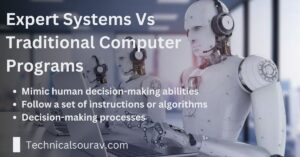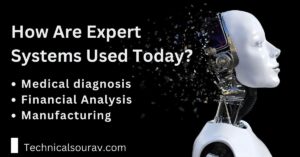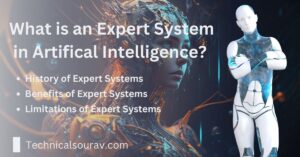Welcome to the world of AI, my dear readers! Today, we will explore a fascinating topic that will make you feel like an AI expert in no time. So, grab your popcorn, put on your thinking cap, and ask, “What is an expert system in AI?” Get ready to learn about it.
An expert system in AI is like your own Sherlock Holmes, who deeply understands a specific area or problem. These systems are designed to mimic the decision-making process of a human expert using a set of rules and knowledge stored in a knowledge base. They can analyze data, make decisions, and explain their conclusions.
You might think, “Why do we need a virtual Sherlock Holmes when we already have human experts?” Well, the answer is simple, my dear reader. Expert systems can analyze large amounts of data in a short amount of time, make objective decisions, and provide consistent results. Unlike human experts, they don’t get tired or biased and can work around the clock. Also, they will not demand a pay hike or a day off. So, in a way, they are the ideal employee.
But wait, there’s more! Expert systems can be used in many fields, from medical diagnosis to financial planning and even video games. Yes, you read that right. Even video games can use specialist systems to create challenging opponents that can adapt to the player’s play style. So, whether you’re a doctor, a financial analyst, or a gamer, Expert Systems can make your life easier and more enjoyable. So, let’s dive into the world of expert systems in AI and learn how they work and why they are essential in artificial intelligence.
What is an Expert System?
An expert system is a type of artificial intelligence (AI) technology designed to emulate the decision-making ability of a human expert. It uses a knowledge base and a set of rules to make decisions like a human expert. A knowledge base is essentially a database of information that expert systems can draw from to make decisions. At the same time, rules are a set of guidelines that determine how the system should make those decisions.
How Do Expert Systems Work?
Expert systems work by using a process called inference, which is essentially a way of drawing conclusions based on available information. The system uses the rules in its knowledge base to evaluate the available data and arrive at conclusions. It then presents this conclusion to the user in a way that is understandable and easy to understand.
Expert systems can also be designed to learn from new information, making them more accurate and effective over time. This is done through machine learning, where the system is trained on new data and adjusts its rules accordingly.
Difference Between Expert Systems and Traditional Computer Programs
The main difference between expert systems and traditional computer programs is that expert systems are designed to mimic the decision-making ability of a human expert. Conventional computer programs, on the other hand, are designed to perform specific tasks or operations based on a set of predetermined rules or instructions.

Expert systems are also more flexible than traditional computer programs, as they can adapt to new situations and learn from new information. They are particularly useful in highly complex or uncertain situations, as they can help improve decision-making accuracy and reduce the risk of human error.
Overall, expert systems are a powerful tool in the field of AI, with a wide range of applications in various industries. They provide an efficient and effective way to access expert knowledge and make informed decisions and are likely to become even more important as AI technology develops.
Types of Expert Systems
Expert systems are widely used in various industries, from healthcare and finance to manufacturing and logistics.
One of the major advantages of expert systems is their ability to handle complex data and make accurate decisions based on that data. However, not all expert systems are created equal – there are many different types of expert systems, each with strengths and weaknesses.
In this section, we’ll explore the different types of expert systems in detail, including rule-based systems, fuzzy systems, and neural networks. We’ll explain how each type of system works and provide examples of how they are used in real-world applications. Whether you’re new to AI technology or an experienced practitioner, understanding the different types of expert systems is essential to staying on top of the latest developments in this fast-paced field.
- Rule-Based Systems
Rule-based systems are the most common type of expert system. They are designed to make decisions based on a set of rules, which are essentially a series of “if-then” statements. For example, an expert system designed to diagnose medical conditions might have a rule that states, “If the patient has fever and cough, the diagnosis is likely pneumonia.”
Rule-based systems evaluate the available data and apply appropriate rules to conclude. They are accurate, effective, and widely used in various industries, including health care, finance, and manufacturing.
- Fuzzy Systems
Fuzzy systems are a type of expert system designed to deal with uncertainty and inaccuracy in data. They are based on the principles of fuzzy logic, which allows for degrees of truth rather than just true or false values.
Fuzzy systems assign a degree of membership to each piece of data based on how closely it matches available criteria. For example, an expert system designed to recommend products to customers might assign a degree of membership to each product based on how closely it matches the customer’s preferences.
Fuzzy systems are beneficial in situations where there is a high degree of uncertainty or where accurate measurements are difficult to obtain. They are used in various applications, including image recognition, speech recognition, and control systems.
Nervous System
Neural networks are a type of expert system based on the structure and function of the human brain. They are designed to learn from experience and improve their performance over time.
Neural networks process data through interconnected nodes, or “neurons”. Each neuron takes input from the previous layer of neurons and applies a set of weights to that input, which determines its output. The output of each neuron is then passed on to the next layer of neurons, and the process continues until a final output is generated.
Neural networks are used in various applications, including image recognition, natural language processing, and predictive analysis.
There are many expert systems, each with strengths and weaknesses. By understanding the different types of expert systems and how they work, we can better understand the power and potential of AI technology.
History of Expert Systems
The history of expert systems is a fascinating story of how artificial intelligence has evolved. From its earliest beginnings in the 1950s and 1960s to the present day, expert systems have played an important role in various industries and applications.
This section explores expert systems’ origins and evolution over time. We’ve seen how early systems like Dendral paved the way for later rule-based and fuzzy logic-based systems and how breakthroughs like IBM’s Deep Blue and Watson demonstrated the power of neural networks and natural language processing.
One thing has remained constant through it all – the promise of expert systems to improve decision-making and streamline complex processes. As AI technology continues to evolve, it is clear that expert systems will play a significant role in shaping the future of industries and society as a whole.
Origin of Expert Systems
Expert systems have their roots in the field of artificial intelligence (AI), which emerged in the 1950s and 1960s. Early AI researchers were interested in developing computer programs that mimic human intelligence and decision-making processes.
One of the earliest examples of an expert system was the Dendral system, developed at Stanford University in the late 1960s and early 1970s. Dendral was designed to assist chemists in identifying the molecular structure of organic compounds based on mass spectrometry data.
Later, many other expert systems were developed in various fields, including medicine, engineering and finance. These systems were typically based on rule-based approaches and were designed to replicate the decision-making processes of human experts.
Major Milestones in the History of Expert Systems
Over the years, expert systems have continued to evolve and improve. Here are some major milestones in the history of expert systems:
- 1980: The MYCIN system is developed at Stanford University, which uses rule-based logic to diagnose bacterial infections.
- 1986: The first professional expert system, XCON, is developed by Digital Equipment Corporation. XCON is used to configure complex computer systems.
- 1990: Fuzzy logic-based expert systems became increasingly popular, allowing for more flexible and nuanced decision-making.
- 1997: IBM’s Deep Blue defeats world chess champion, Garry Kasparov, demonstrating the power of neural network-based expert systems.
- 2011: IBM’s Watson appears on the game show Jeopardy!, demonstrating the potential of natural language processing-based expert systems. beat human competitors.
Today, expert systems remain an important area of research and development in the field of AI. With advances in machine learning, natural language processing, and other technologies, the potential applications of expert systems are only increasing.
How Expert Systems Are Used Today
Are you tired of making complex decisions based on incomplete or misleading data? Would you like a trusted advisor with the knowledge and experience to guide you to the right choice? Look no further than Expert Systems!

Expert systems are computer programs that use artificial intelligence to replicate the decision-making processes of human experts. They can be used in various industries and sectors to improve decision-making, reduce errors and increase efficiency.
So, how are expert systems used today? Here are a few examples:
- Medical Diagnosis
Expert systems are used in health care to assist doctors and other health professionals in diagnosing and treat patients. For example, the Mycin system, developed in the 1980s, uses rule-based reasoning to diagnose bacterial infections. Similarly, the Isabelle system uses probabilistic reasoning to help doctors identify rare diseases.
- Financial Analysis
Expert systems are used in finance to analyze large amounts of data and make investment decisions. For example, the Autonomics system uses fuzzy logic to help financial analysts evaluate the creditworthiness of borrowers.
- Manufacturing
Expert systems are used in manufacturing to monitor production processes and optimize efficiency. For example, the General Motors Proving Ground uses an expert system to predict vehicle performance in various weather conditions.
As you can see, expert systems are a powerful tool that can be applied across various industries and sectors. By leveraging the latest in artificial intelligence and machine learning, expert systems can help us make better decisions, reduce errors, and improve outcomes. So why not let the experts lend a hand?
Benefits of Expert Systems
Expert systems are a form of artificial intelligence that mimic the decision-making processes of human experts. They have been developed to solve complex problems and have many applications. Expert systems can be used to improve accuracy and efficiency, reduce human error, and save time and money. In this article, we’ll explore the potential benefits of expert systems and how they can be used to enhance decision-making.
Increased Accuracy and Efficiency
Expert systems use a set of rules and criteria to make decisions, which can be much more consistent and accurate than human decision-making. This can lead to fewer errors and better results. By automating decision-making processes, expert systems can perform tasks faster and more efficiently than humans, thereby increasing productivity.
Less Human Error
Human experts are prone to make mistakes, especially when dealing with complex or unfamiliar situations. Expert systems can guide and support human experts to help them avoid errors and make better decisions. Expert systems can improve decision-making outcomes and prevent costly mistakes by reducing human error.
Time and Cost Savings
Expert systems can perform tasks faster and more efficiently than humans, saving significant time and cost. By automating decision-making processes, expert systems can free human experts to focus on other tasks, leading to increased productivity and better results.
Finally, expert systems provide many potential benefits for decision-making, including increased accuracy, efficiency and productivity, reduced human error, and time and cost savings. As technology advances, expert systems become more sophisticated, and their applications expand, making them an increasingly valuable tool for decision-making across various industries and sectors.
Limitations of Expert Systems
Expert systems are designed to replicate the decision-making processes of human experts in various fields. While they have many potential benefits, they also have some limitations. In this section, we will explore some of the major limitations of expert systems and how they can be addressed.
- Extensive knowledge representation
One of the main limitations of expert systems is that they require extensive knowledge representation. All the knowledge needed to make decisions must be explicitly programmed into the system, which can be time-consuming and complex. Furthermore, expert systems require constant maintenance and updates as knowledge evolves to remain accurate and relevant.
- Potential Bias
Another limitation of expert systems is that they can potentially be biased. This is because the knowledge and rules programmed into the system are based on human expertise and may reflect the biases and assumptions of their creators. This can lead to errors or mistakes in decision-making, which can have serious consequences.
To overcome these limitations, several strategies can be employed. For example:
- Knowledge Management
Expert systems can benefit from robust knowledge management systems that help capture, organize, and maintain the knowledge needed to make decisions. This can help ensure that the system remains accurate and up to date.
- Validation and Testing
Expert systems must be thoroughly tested and verified to ensure that they are accurate and free from bias. This may involve comparing the system’s output with decisions made by human experts to identify any inconsistencies or errors.
- Continuous Learning
Expert systems can benefit from ongoing learning and improvement. By analyzing the decisions made by the system and providing feedback, the system can learn and adapt over time, leading to better decision-making results.
Finally, while expert systems offer many advantages, they also have some limitations to consider when using them. By addressing these limitations through knowledge management, validation and testing, and continuous learning, expert systems can be a valuable tool for decision-making in various industries and sectors.
Expert Systems vs Machine Learning
Artificial Intelligence has revolutionized the way of problem-solving and decision-making. Expert systems and machine learning are two of the most widely used AI techniques. While both approaches share some similarities, they differ significantly regarding their capabilities and limitations. In this article, we will compare and contrast expert systems with machine learning and explore how these two AI techniques can be used together to create more powerful AI applications.
Expert System vs Machine Learning: Differences and Similarities
Expert systems rely on pre-defined rules and knowledge representations to make decisions, while machine learning algorithms use data to learn and make predictions.
Expert systems are typically used for decision-making when human expertise is required. At the same time, machine learning is more often used for tasks such as pattern recognition and predictive modelling.
Both expert systems and machine learning have their strengths and limitations, and it is important to understand the differences between them when deciding which approach to use for a specific task.
Combination of expert systems and machine learning
Expert systems and machine learning can be used together to create more powerful AI applications. For example, an expert system may provide initial rules and knowledge representations, which can then be refined using machine learning algorithms.
Combining these two approaches may help overcome some of each approach’s limitations. For example, machine learning can help overcome the need for extensive knowledge representation in expert systems, while expert systems can help reduce potential biases of machine learning algorithms.
By combining the power of expert systems and machine learning, we can develop more sophisticated AI applications that are better suited to solving complex real-world problems.
Examples of Expert Systems
Here are some examples of Expert Systems.
- A notable example of an expert system is NASA’s Remote Agent, which was developed to help astronauts diagnose and repair problems on the International Space Station (ISS). The remote agent system uses a combination of rule-based reasoning and machine learning to analyze sensor data and provide clinical recommendations to astronauts. This expert system has helped NASA reduce the time and resources required to troubleshoot and maintain the ISS.
- Another well-known example of an expert system is Mycin, a medical diagnosis system developed in the 1970s. Mycin was designed to assist doctors in diagnosing and treating bacterial infections by analyzing patient data and providing treatment recommendations based on a set of rules and inferences. Mycin achieved a level of diagnostic accuracy comparable to that of human experts, making it a significant achievement in the field of medical AI.
These examples demonstrate the potential of expert systems to revolutionize industries and solve complex problems. As technology develops, we expect more innovative applications of expert systems in various fields.
Finally, expert systems are an important aspect of AI that allows computers to mimic human decision-making processes. We begin our discussion of expert systems and how they work by highlighting the differences between them and traditional computer programs. We then trace the history of expert systems and how they have evolved, including some of the key milestones in their development.
We also discuss different types of expert systems, such as rule-based and fuzzy systems, and provide examples of how they are used in various industries and sectors, such as medical diagnosis and financial analysis. We outline the potential benefits of using expert systems, such as increased accuracy and efficiency, and how they can help reduce human error and save time and money. Additionally, we examine the limitations of expert systems and how these limitations can be addressed.
We compare and contrast expert systems with other AI techniques, such as machine learning, and explain how expert systems can complement or be used with machine learning. Overall, expert systems have an important role in various industries, and as technology continues to develop, they become even more important in solving complex problems and decision-making processes.
You may also read these articles.


